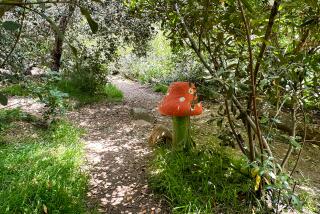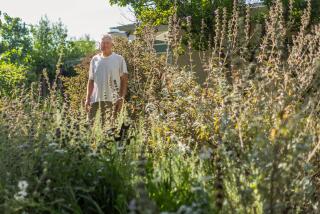Into the woods

I was determined to simply sit and soak in the surroundings on this trip to our mountain property. Until this Saturday, there had been work to do on every visit since my wife and I bought the 40 wooded acres last winter. There was still plenty to do, but it could wait since I was alone this day. I walked a few hundred yards up the canyon to where early wildflowers were blooming and sat down on a log.
Things were slowly coming back to life with spring — grasses growing and songbirds singing. A woodpecker pounded out a beat on a dead tree, and blue jays complained noisily about something (maybe me). One lone butterfly floated down the canyon on a gentle breeze. I could see slivers of snow on the north-facing slopes and towering cumulus clouds lingered from the last storm, crisp white against the deep blue sky.
The early flowers, short and compact as mountain flowers often are, formed puddles of lavender beside the pines. Looking at them, I felt I had my own little Poppy Preserve. Here and there were dots of clear bright yellow, and when I looked closely I realized they were wild violets.
Having violets made my little wildflower patch feel quite garden-like, though we have no intention of making a garden here, two hours from Los Angeles in an area that shall remain nameless to keep the good graces of our new neighbors and our privacy.
Iris and I have a delightful little garden at our West Los Angeles home, and friends assumed we would have one at our second property as well. “What are you going to plant?” they excitedly ask, and they look incredulous when I answer, “Nothing.”
Up here, nature has done quite a nice job planting a garden. I wish ours at home were as simple and elegant.
So we would mostly garden by subtraction. This is what Iris had been doing the weekend before, sawing off the lower dead limbs from some of the trees and taking out a few small shrubs that were growing in awkward spots.
In the vicinity of the old railroad car that serves as a second home “cabin” of sorts, she even raked up the larger twigs and branches, being careful to leave all the pine needles, leaf litter and small stuff, to make a thick mulch to fertilize the soil.
In some areas, we are leaving entire fallen trees on the ground to decay slowly. We have even left standing a few gray skeletons to provide grubs and shelter for woodpeckers and a place for hawks to perch. Naturalists have found that dead trees, or “snags” as they’re called, harbor more life than the living.
But there are limits. We hauled away unsightly dead branches near the railroad car because they could be a fire hazard. Back in winter, right after the close of escrow, we had to remove a number of dead pines for the same reason.
There are dead and dying pines all over the southwest but especially in Southern California’s mountains. Looking on the Web we learned that the pines were being killed by beetles living under the bark or by a parasite called dwarf mistletoe. Pitch running down the sides of infested pinyon pines gave the beetles away, and the yellow-orange string-like dwarf mistletoe was plainly visible on the branches of a few Ponderosas.
These problems are always present in forests, but the drought of the last few years has left many trees weak and nearly defenseless. We have trees that are under attack and some that have already died. Once pines succumb to either killer, there is little or nothing to be done except to remove the trees to slow the spread and hope for more rainy years like this one.
We had nine dead pinyon pines to take out, and I was quite relieved to find that felling trees in a forest is a lot easier, and considerably less expensive, than removing them from a suburban backyard — if the trees aren’t too tall and there’s nothing they might fall on. One estimate to cut down the trees, the tallest being a 70-footer, and haul away some debris was for $1,000. Take out a single tree in a backyard and it alone can cost that.
I thought I might do the job myself and save the thousand bucks, so I bought a chain saw on sale, but after a few weekends spent cutting and cleaning up, the $1,000 seemed quite reasonable. Three guys showed up a week later with much bigger saws and a dump truck.
One by one the trees fell with muffled thuds, and when it was all over, I was left with a mountain of wood cut into 18-inch lengths. In the woods you slice up cut trees like carrots to use for firewood. Only the twiggy branches get trucked away.
We asked the tree cutters to cut one big stump level and at table height. We put a couple of logs around it and now have a place for a sit-down picnic, an unplanned bonus.
Pinyon pines were favored by the railroads in the 1800s for firing steam locomotives because they burn fast and hot. I figured they would make good firewood for the hearth at home and for the old wood-burning stove in the railroad car. Even if we never get around to building on this property, it would provide a great wood lot. A neighbor put it succinctly while looking at the many dead trees on his property. “At least we’ll never run out of firewood.”
The big timber rounds had to be split, and this was something I could do. There are machines that do the job with pneumatic force, but I really like splitting wood. Frustrated by traffic or long lines at the post office? Split wood for a weekend with an 8-pound splitting maul and a few wedges. You’ll feel much better.
Of course, I should point out that pine is easy to split. I filled the back of my little SUV and made a nice stack beside the old train car and I’d hardly made a dent in my pile.
Removing the dead trees left part of the metal railroad car baking in the sun, so we decided to replace them with a small grove of quaking aspen and a shrubby native willow. It might be too dry for the native aspens, but I’ve always loved this mountain tree. It shimmers all summer, then burns like little suns in autumn. The trees make ribbons of molten gold on the sides of the Eastern Sierra in October or November
We also planted a small willow with striking golden stems. I took cuttings from a nearby plant one weekend, rooted them and planted them a month later. Willows also need water, but this one grows wild not far from our property, so I’m hoping its offspring will survive in our dry canyon.
That might be the end of our planting, though a clump of daffodils surprised us a few weeks ago when they popped up near the dirt drive. Presumably the previous owner planted them. The bright yellow flowers look so good I may plant a whole drift of them. I once visited a breathtaking garden filled with thousands of daffodils that was located high, as our property is, at about 5,500 feet.
But that will probably be it for planting. This garden will be as nature intended, a wild counterpoise to our city plot.
Next: Figuring out what to do with the old train car.
More to Read
Sign up for Essential California
The most important California stories and recommendations in your inbox every morning.
You may occasionally receive promotional content from the Los Angeles Times.






